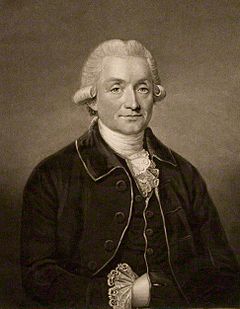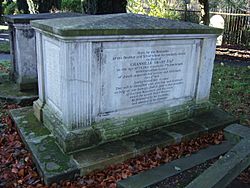William Sharp (surgeon) facts for kids
Quick facts for kids
William Sharp
|
|
|---|---|
 |
|
| Born | 1729 |
| Died | 17 March 1810 |
| Occupation | Surgeon |
| Employer | George III |
| Spouse(s) | Catherine (née Barwick) |
William Sharp (born 1729 – died 17 March 1810) was an English physician. He is known for being a surgeon to King George III. Along with his brother Granville Sharp, he was a strong supporter of the early fight against slavery in Britain.
William Sharp also asked for a famous painting to be made. It showed his large family playing music together on a boat.
Contents
Early Life and Learning
William Sharp was born in 1729. His father was Thomas Sharp, an important church leader. His grandfather, John Sharp, was also a churchman who became the Archbishop of York.
William was one of thirteen children. When he was fourteen, he left his home in Northumberland. He moved to London to study surgery and become a surgeon.
His Work as a Surgeon
In 1755, William Sharp started working at St Bartholomew's Hospital in London. He was an assistant-surgeon there. He worked at the hospital until 1779.
He wrote some medical papers. One paper suggested using pasteboard to make splints for broken bones. This was a new idea at the time.
William Sharp became a member of the Fellow of the Royal Society in 1769. This was a big honor for scientists and thinkers.
People at the time said he was a "very important surgeon in London." It is also said that he turned down an offer to become a baronet. This special title was offered because he successfully helped Princess Amelia when she was sick.
For many years, William and his wife lived on a barge (a type of boat) on the River Thames. Later in his life, he lived at Fulham House in Fulham.
William Sharp married Catherine Barwick. They had one daughter named Mary. Mary later married Thomas John Lloyd Baker and had three children.
Helping Others: The Jonathan Strong Case
William Sharp often helped poor people in London at his home. One night, a slave named Jonathan Strong came to him for help. Jonathan had been badly beaten by his owner.
Sharp treated Jonathan, who needed four months to recover. William Sharp paid for Jonathan's care. He also helped Jonathan find a job with a pharmacist.
Two years later, Jonathan's former owner, David Lisle, saw him. Lisle sold Jonathan to a Jamaican planter and had him kidnapped. Jonathan managed to send a message to William's brother, Granville Sharp.
Granville Sharp quickly got involved. He went to the Lord Mayor of London, who held a hearing. The Lord Mayor declared Jonathan Strong to be free. Lisle then challenged Granville to a duel, but Granville refused. The English courts eventually agreed with the Sharp brothers. This case was a big step in the fight against slavery. Granville Sharp became a leading voice for the abolition of slavery.
The Famous Family Painting
William Sharp and his family loved music. They often met on their barge on the River Thames to play music for guests. William played the organ and French horn. His brother Granville played many instruments, including the clarinet and flute. Their sisters sang and played the piano.
William Sharp asked a famous artist named Johann Zoffany to paint his family. The painting is called The Family of William Sharp: Musical Party on the Thames. It was painted between 1779 and 1781.
The painting shows William Sharp at the top, raising his hat. He is wearing a special red uniform. The painting is now in the National Portrait Gallery in London. It shows how important music and family were to William Sharp.
His Final Resting Place

William Sharp died in 1810 when he was 81 years old. He was buried at All Saints' Church, Fulham. His sister Elizabeth was buried next to him.
Their shared tomb has a special message. It says they were "loved and pleasant in their lives, and in their deaths they were not divided." This means they were very close.
Later, in 1813, his brother Granville Sharp was also buried beside them. A special memorial was put up in the church in 1845. It honors William Sharp, his wife Catherine, and his brother Granville Sharp.


